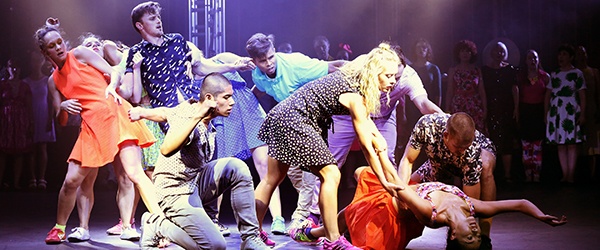Home | Blog | Social Dance at the Sydney Festival
Social Dance at the Sydney Festival
Image: Prudence Upton
Movement- lubricant for the masses.
The term ‘social dance’ conjures specific images; court dances with buckled belts and shoes on display, the Lindy Hop with hijinks and knicker glimpses, as bodies are back-flipped over shoulders, The Swim, The Watusi and The Twist, Hip Hop and Street, with fat beats and head spins, punk pogos, crowd surfing, body slamming, sweat sharing, as individuals are flanked like redheads in a matchbox, overcrowded and too close touching.
My first social dance experiences unfolded in our living room or backyard garage, amidst extended family and my parents’ close friends and neighbours. Adults coupled up and we wove intricate patterns around them playing chasings, before being banished to the back room, lest our reckless interactions caused the needle, spinning on the record player, to jump off the 45.
The last time I witnessed a performance, which served as commentary on social dance, was Sue Healey’s Suite Slip’d. I recall the complicated floor patterns and delicate partnering, all alluding to the physical restraint of the Baroque period (when compared to the permissive attitudes and actions of contemporary social custom). I recall witnessing dancer Phillip Adams casually flick his female partner’s hemline with lascivious intent and feeling he had violated her. I returned the next night to see if this was improvised. It was not. The action was so offhand, so casual and seemingly insignificant, yet so compelling.
My primary training is in Australian Aboriginal and Torres Strait Islander dance forms. According to Wikipedia these dances are broadly referred to as ceremonial; traditional cultural or religious observances. They are also the epitome of social dance, with elders who can hardly walk on a good day, participating alongside toddlers in pilchers. Knowledge is shared across the generations, patience and tolerance for each other, an underlying lesson.
It’s fortuitous that the last three Sydney Festival events I attended had inclusivity as the focus.
PUNCTURE, a collaborative venture between Legs On The Wall, FORM Dance Projects and VOX, Sydney Philharmonia Choirs, was comprised of a large ensemble of performers and was dedicated to the social form through group dance and choral song, adding elements of circus and film projection. This was a joyful experience, celebrating the overwhelming positive effects of organised social interaction. Kathryn Puie’s choreography, under the direction of Patrick Nolan, showcased her extraordinary breadth of physicality, to include suspended harness work, utilised in a double trio tango and a contemporary crowd surfing mosh pit.
Kate Champion’s swan song as artistic director and founder of Force Majeure, fought for the fat body in Nothing to Lose. Big men and women danced in defiance, they lured us with soft undulating flesh, shared others’ secret desires to fantasise and fetishise, which culminated in an augmented cast dance off. It was fierce and fitting.
Urban Theatre Projects’ Bankstown Live, offered a mix of interdisciplinary expression, celebrating diversity in the greater west of Sydney. The lines of performer/observer blurred by intimate gatherings in personal spaces- the front and backyards of the Northam Ave hosts.
These three works celebrated our need to socialise, to interact and the importance and power of the collective voice. It is comforting to realise that in our push to stand out as individuals, there is merit in being able to define and align ourselves with others.
– by Vicki Van Hout

